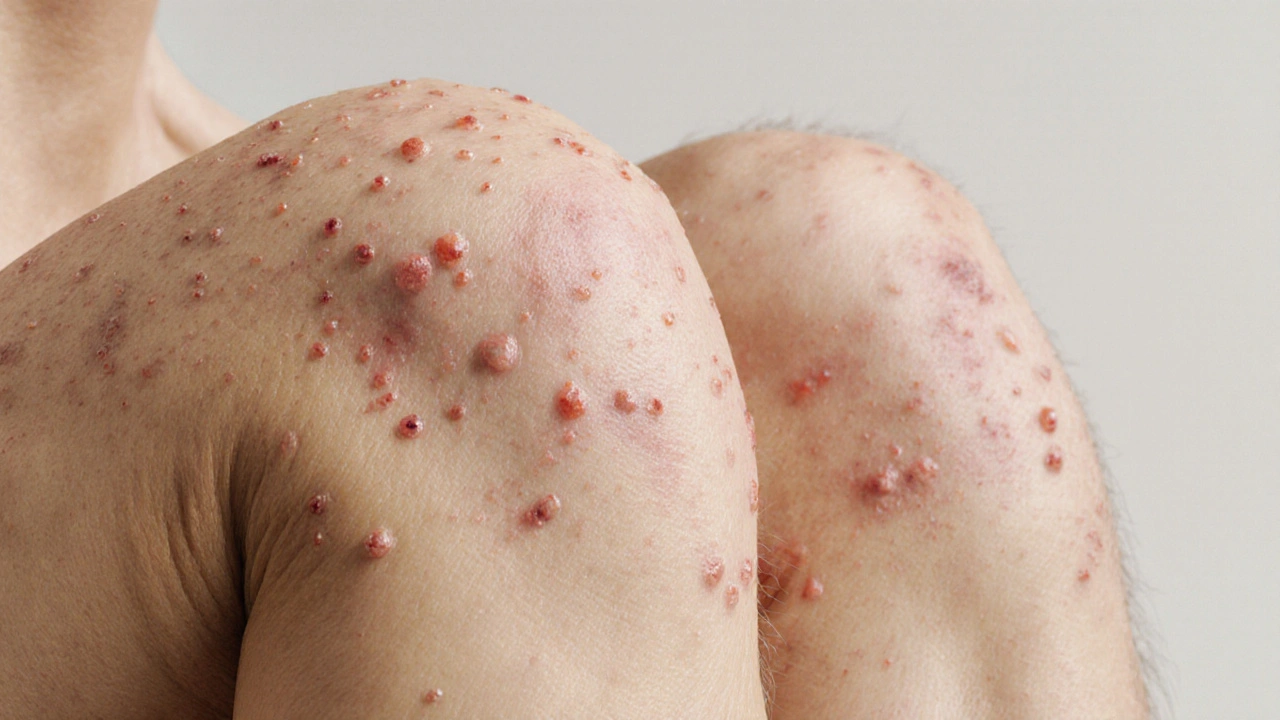Dermatitis Herpetiformis Dermatologist Selector
This tool helps you evaluate potential dermatologists based on key criteria for managing Dermatitis Herpetiformis (DH). Assign a score (0-2) to each criterion and compare options.
Experience with DH
Direct expertise speeds diagnosis and treatment.
What to look for: At least 3-5 DH patients per year, publications, or conference talks.
Board Certification
Ensures formal training and ongoing education.
What to look for: American Board of Dermatology, plus sub-specialty fellowship if listed.
Location & Accessibility
Frequent visits may be needed for medication monitoring.
What to look for: Within 30-minute drive, offers tele-dermatology follow-ups.
Insurance Acceptance
Reduces out-of-pocket costs for biopsy and meds.
What to look for: List of accepted plans on website or verified by call.
Patient Reviews & Outcomes
Real-world feedback hints at bedside manner and effectiveness.
What to look for: Average rating ≥4.5 on reputable health-review sites.
Collaboration with Gastroenterology
Coordinated care improves dietary compliance and serology tracking.
What to look for: Joint clinic notes, referral network mentioned in profile.
Total Score: 12/12
When you hear about Dermatitis Herpetiformis is a chronic, intensely itchy skin condition linked to celiac disease, characterized by small, blister‑like bumps, the first question is often "who should I see?" The answer isn’t just any skin doctor - you need a clinician who understands the autoimmune connection, the role of a gluten‑free diet, and the specific diagnostic tools like a skin biopsy. Below are practical tips that walk you from basic facts to booking the right appointment.
What Exactly Is Dermatitis Herpetiformis?
Dermatitis Herpetiformis (DH) is an autoimmune skin disorder that shows up as clusters of raised, itchy papules, often on elbows, knees, buttocks, or scalp. The rash looks like tiny hives but never turns into a full blister. Under the microscope, doctors see deposits of IgA antibodies along the dermal‑epidermal junction. Those antibodies are the same ones that attack the small‑intestine lining in celiac disease. This is why a strict gluten‑free diet often eases the skin symptoms within weeks.
Key attributes of DH:
- Intense burning or stinging sensation
- Symmetrical distribution on extensor surfaces
- Positive anti‑tissue transglutaminase (tTG) IgA blood test in most patients
- Improvement with dapsone medication and gluten avoidance
Because the condition bridges dermatology and gastroenterology, not every dermatologist will have the experience needed to manage it fully.
Why a Specialist Dermatologist Matters
A "general" skin doctor can treat acne, eczema, or psoriasis, but DH requires a clinician who knows how to interpret a skin biopsy that shows granular IgA deposits, coordinate with a gastroenterologist for dietary counseling, and prescribe dapsone safely. The right dermatologist will:
- Order the correct skin biopsy technique (direct immunofluorescence) and interpret the results.
- Understand the link between DH and celiac disease, so they can recommend appropriate serology testing.
- Adjust dapsone dosing based on blood counts, a nuance often missed by providers unfamiliar with the disease.
- Provide guidance on a lifelong gluten‑free diet and monitor nutritional deficiencies.
These competencies dramatically affect how fast you get relief and how well you avoid complications like anemia or chronic skin damage.

Key Criteria for Choosing a Dermatologist
When you start searching, treat the selection process like a checklist. Below is a comparison table that highlights the most important factors.
| Criterion | Why It Matters | What to Look For |
|---|---|---|
| Experience with DH | Direct expertise speeds diagnosis and treatment. | At least 3‑5 DH patients per year, publications, or conference talks. |
| Board Certification | Ensures formal training and ongoing education. | American Board of Dermatology, plus sub‑specialty fellowship if listed. |
| Location & Accessibility | Frequent visits may be needed for medication monitoring. | Within 30‑minute drive, offers tele‑dermatology follow‑ups. |
| Insurance Acceptance | Reduces out‑of‑pocket costs for biopsy and meds. | List of accepted plans on website or verified by call. |
| Patient Reviews & Outcomes | Real‑world feedback hints at bedside manner and effectiveness. | Average rating ≥4.5 on reputable health‑review sites. |
| Collaboration with Gastroenterology | Coordinated care improves dietary compliance and serology tracking. | Joint clinic notes, referral network mentioned in profile. |
Use this table as a scoring sheet. Assign a point value (0‑2) for each criterion, sum the scores, and compare at least three doctors before deciding.
Where to Search for the Right Provider
Here are practical avenues to locate a dermatologist who checks the boxes above:
- Professional directories: The American Academy of Dermatology (AAD) offers a searchable “Find a Dermatologist” tool where you can filter by specialty and location.
- Patient advocacy groups: Celiac disease organizations often maintain lists of clinicians experienced with DH.
- Hospital affiliations: University medical centers typically have dermatology departments that run DH clinics.
- Referrals from your gastroenterologist: A gastroenterology doctor who manages your celiac care likely knows a dermatologist they trust.
- Online health platforms: Services like Zocdoc let you read verified patient reviews and see which doctors advertise DH expertise.
When you find a name, cross‑check the criteria table. Don’t rely on a single source; a combination of professional listings and patient feedback gives the clearest picture.
Preparing for Your First Dermatology Appointment
Even the best dermatologist can’t help if you walk in unprepared. Bring the following:
- Recent blood test results (tTG IgA, total IgA levels).
- Any prior skin biopsy reports.
- A list of current medications, especially dapsone or sulfa drugs.
- A brief food diary highlighting gluten exposure.
- Questions you want answered (e.g., "How often should I have blood work while on dapsone?")
Ask the doctor to explain how they will monitor side effects and whether they collaborate with a gastroenterologist. Clarifying these points early prevents miscommunication later.
Common Pitfalls and Pro Tips
Pitfall #1: Choosing a dermatologist based solely on proximity. The closest office may lack DH experience, leading to repeated biopsies or delayed symptom relief.
Tip: Prioritize experience and board certification; distance matters only after those are satisfied.
Pitfall #2: Assuming dapsone alone cures DH. While dapsone controls the rash, it does nothing for the underlying gluten trigger.
Tip: Pair medication with strict gluten avoidance; schedule nutrition counseling if needed.
Pitfall #3: Ignoring insurance coverage. Skin biopsies and long‑term dapsone therapy can become costly.
Tip: Verify coverage before the first visit; ask the clinic’s billing staff for a cost estimate.
Next Steps After Your First Visit
1. Review the biopsy results and confirm the diagnosis.
2. Set a medication schedule with follow‑up labs every 2‑4 weeks initially.
3. Adopt a certified gluten‑free diet; consider a dietitian referral.
4. Keep a symptom diary for at least 3 months to track improvement.
5. Schedule a 3‑month check‑in with the dermatologist to adjust treatment if needed.
Following these steps gives you the best chance of clearing the rash, preventing complications, and maintaining long‑term skin health.
Frequently Asked Questions
Can any dermatologist treat Dermatitis Herpetiformis?
While any board‑certified dermatologist can perform a skin biopsy, only those who routinely see DH patients understand the specific immunofluorescence pattern and the need for coordinated gluten‑free diet counseling. Look for experience, publications, or a DH clinic affiliation.
Is a skin biopsy always required?
The gold standard for DH diagnosis is a direct immunofluorescence (DIF) skin biopsy. Blood tests for IgA anti‑tTG can suggest celiac disease, but without the biopsy the rash may be mistaken for other conditions.
How long does it take for a gluten‑free diet to improve the rash?
Most patients notice a reduction in itching within 2‑4 weeks, and the rash often clears completely after 6‑12 months of strict gluten avoidance.
What are the side effects of dapsone?
Common side effects include hemolytic anemia (especially in G6PD‑deficient patients), methemoglobinemia, and occasionally liver enzyme elevations. Regular blood counts are essential during the first few months.
Do I need a gastroenterologist if I have DH?
Yes. A gastroenterologist can confirm celiac disease, monitor intestinal healing, and help you navigate the gluten‑free diet, which in turn reduces skin symptoms.
